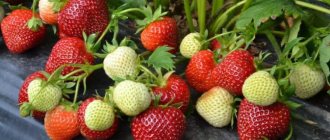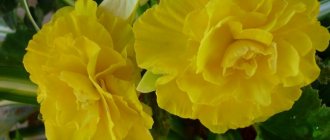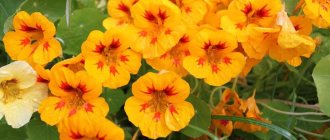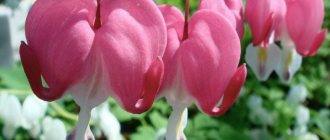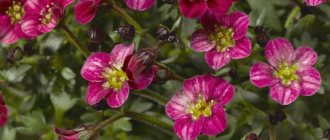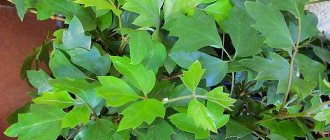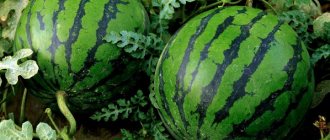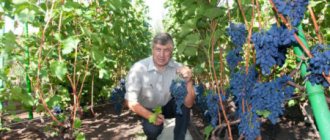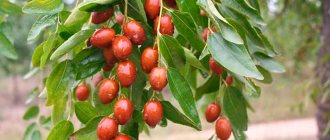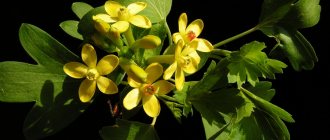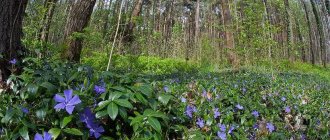We are already accustomed to finding vegetables and fruits from all over the world on store shelves, and we don’t even always know what they are called, where they come from and how to use them. These little-known and rare exotic novelties include jujube fruits, known as “Chinese dates” (Ziziphus jujuba).
These fruits are delicious and contain many healthy ingredients. We will tell you in this article what beneficial properties and contraindications jujube (unabi) has, what it is, what useful vitamins and microelements it contains.
What is unabi?
Jujube is also called unabi, the Chinese date. The tree originates from the regions of East Asia (China, India) and Japan, where it is found not only in the wild, but is also grown in gardens as a useful plant. It is believed that unabi is native to Syria and North Africa, where the plant appeared 3,000 years ago. It then headed east to South Asia and eventually to China, where it is widely cultivated.
Photo. Chinese dates - tree and fruit
The tree is grown in Madagascar, Bulgaria, some other parts of Europe and the Caribbean. Jujube can be grown in our conditions, in warm regions, where it also serves for decorative purposes. The Crimean jujube is known, which grows throughout the Crimea; a garden has been established in the Solnechnaya Valley. The fruit bears fruit well.
The plant has the form of a magnificent shrub or small tree with elliptical green leaves and stiff, branched shoots covered with several thorns growing at the base of the leaves.
The unabi fruit is large, oblong, red, stone fruit, resembling a plum or kiwi in appearance, and an apple in taste. Now let's find out why jujube is useful. Unabi includes a huge amount of vitamins, minerals, valuable amino acids, flavonoids, glycosides, alkaloids and many other biologically active substances.
This is interesting! Koreans use unabi wood to create a wide range of things: bowls, beads, violin parts and double reed drums.
Growing in the garden
Wild and cultivated jujube, the beneficial properties of which are known in Chinese medicine, prefers higher ground. The plant loves warmth and sun, although among the 400 varieties there are also frost-resistant trees. They can withstand temperatures down to -25 0C.
In order for a tree not only to grow in the garden, but also to produce good harvests, it needs to choose the right place.
Description of the landing site:
- Flat sunny area;
- Protection from drafts and wind;
- Location near buildings;
- South or southwest side.
The Chinese date does not grow in lowlands and does not tolerate strong winds and drafts. If the summer is not sunny, the tree may bloom, but there will be no ovaries on it.
Content of vitamins and minerals
Jujube, resembles an apple or Hungarian plum. This fruit is little known here, but it has been used in traditional Chinese medicine for more than 4,000 years. It's easy to guess that this fruit with red or brown skin and sweet pulp has a number of health benefits.
| Vitamin content in 100g jujube |
Energy composition of jujube:
- 93% carbohydrates,
- 5% protein,
- 2% fat.
A handful of fresh jujube fruit contains about 100 mg of vitamin C. This corresponds to approximately 50% of an adult's daily requirement.
Pests and diseases
On the territory of Ukraine and the European part of Russia, no pests or diseases were found on unabi. A common and very annoying problem is cracking of fruits, which occurs from uneven moisture. Such cracked fruits should be processed first.
In its traditional growing area in Central Asia and China, unabi is often affected by codling moths, fruit rot, viral leaf spots and witches' brooms. Theoretically, it is possible for them to appear in our country if the pathogen is introduced with imported fruit or planting material.
Possible pests and diseases and measures to combat them (table)
| Name | What does it look like | What to do about it |
| codling moth | Caterpillars in fruits | Destroy wormy fruits; if there were a lot of them, next year spray the plants with pyrethroid insecticides immediately after flowering |
| Fruit rot | The fruits rot | Collect and destroy rotten fruits; in case of severe damage to fruits directly on the branches, you should contact the phytosanitary service with samples of the affected fruits to accurately determine the pathogen and select the most suitable fungicide |
| Viral spotting | Light spots and stripes appear on the leaves for no apparent reason | Uproot and destroy the diseased plant |
| "Witch's Broom" | Randomly overgrown bunches of shortened branches | Cut down and burn the branch with a witch's broom, taking a large piece of the healthy part |
Unabi problems (photo gallery)
Cracking of fruits occurs due to uneven moisture during their ripening period.
Codling moth caterpillars feed on seeds in unabi fruits
Witch's broom is an ugly growth of branches caused by a fungal or viral infection.
How many calories are in unabi?
A handful of regular jujube berries contains 115 kcal. This corresponds to approximately 5% of the daily caloric needs of an average weight adult with average physical activity.
To burn these calories you will need to warm up a little, namely:
| Mineral content per 100g, mg | |||
| Vitamin A | 40IU | Potassium | 250 |
| Vitamin B1(thiamine) | 0.02 mg | Phosphorus | 23 |
| Vitamin B2 (riboflavin) | 0.04 mg | Magnesium | 10 |
| Vitamin B3 (niacin) | 0.9 mg | Calcium | 21 |
| Vitamin C | 69mg | Zinc | 0,05 |
| Vitamin B6 | 0.08 mg | Sodium | 3 |
| Iron | 0,48 | ||
| 14 minutes | 12 minutes | 11 minutes | 21 minutes | 16 minutes |
| swimming | running | tennis games | horse riding | cycling |
Energy value of 100 g jujube
| calories | carbohydrates | fats | protein | Glycemic index |
| 79 kcal | 20.53 grams | 0.2 grams | 1.2 grams | 70 |
Chemical composition
In medicine and cooking, not only the fruits of the Chinese date are used, but also the bark, seeds, as well as fresh and dried leaves.
100 grams of fresh jujube fruit contains 79 kcal. This is 1.2 g of protein, 0.2 g of fat, 20.2 g of carbohydrates; when dried, the calorie content of dates is much higher, since all the water leaves it and fructose remains.
Due to the high glycemic index (70), the fruits should not be eaten by people with impaired carbohydrate metabolism.
The jujube fruit is rich in vitamins, macro- and microelements:
- vitamins B1, B2, B6, C, A;
- magnesium, phosphorus, potassium, calcium, sodium;
- iron, zinc, copper, manganese.
The fruits of the plant contain organic amino acids, triterpenes, and alkaloids.
The bark and leaves of the Chinese date are not inferior in the richness of their chemical composition. The bark contains:
- saponins;
- routine;
- tannins.
Jujube leaves contain a natural anesthetic. This is a substance that, while chewing the leaves, dulls or completely paralyzes the perception of sweet and bitter tastes, but a person can distinguish between salty and sour.
This property of the plant was used in the pharmacology of past years, when the doctor prescribed a bitter medicine to the patient. Before taking quinine, the patient chewed several fresh tamarind leaves and could safely take unpleasant medications.
Use in cooking
This healthy and tasty fruit has long been eaten in various forms.
Use Cases
In Chinese cuisine, jujube fruits are added to rice dishes, baked goods, and oil is obtained with the addition of sugar, spices and lemon. Dried fruits can replace coffee.
Unabi berries are sweet and tasty, but are rarely eaten raw and are more often used for:
- drying;
- preparing confectionery products – pies, muffins;
- making candy;
- frost;
- canning – jujube jam;
- making wine.
In our country, unabi is still not very popular and is available mainly in dried form, like the unabi date. Sometimes you can see them in large supermarkets, but it is much easier to find them in stores offering oriental food and spices at the market. There you can even buy these interesting fruits in the form of tea, for example tea with jujube and honey (with the consistency of jam).
- In some parts of India, jujube is also used for fermentation.
- Croatians use the fruit to make marmalade, juices and brandy.
Often unabi are dried with the pit, so they must be removed, as is the case with dried plums. Dried fruits after pitting can be considered as:
- healthy snack;
- for preparing compotes;
- addition to pies, baked goods;
- salad ingredient.
Healthy “dates” are also added to soups and meat dishes to add a sweet aftertaste.
Jujube recipes
In the southern regions, jujube is readily grown by gardeners; it can be purchased at local markets. Housewives, of course, came up with recipes to help prepare unabi for the winter.
Dried and dried jujube
Small fruits are convenient to dry or dry. To do this, they need to be washed in water and loaded into a fruit dryer. Store dried dates in clean jars. You can make compotes from dried fruits.
Five-minute unabi jam
For 1 kg of berries – 0.5-0.8 kg of sugar (to taste).
Wash the fruits, prick with a toothpick and cover with sugar. Wait until the unabi releases its juice; it is advisable to leave the fruits overnight. You can add water if there is not enough juice. However, adding water will spoil the taste a little. The jam is cooked in 3 batches for 5 minutes each. Between boiling, allow to cool and soak in unabi syrup. After the third boiling, the jam is preserved in sterilized jars and placed upside down under a blanket.
Pickled jujube
- green jujube (unripe) – 1 kg;
- apple cider vinegar 6% – 100 ml;
- bay leaf, allspice peas - to taste;
- garlic – 3-5 cloves;
- salt (non-iodized) – 3 tbsp. spoons;
- sugar – 2 tbsp. spoons;
- water – 1l;
- vegetable oil – 50 ml.
Place a saucepan with water on the stove, add salt, sugar, spices, vinegar and cook the marinade. Place the green jujube fruits into jars and pour boiling marinade over them, cover with lids and let cool until warm. Drain the marinade and boil again. We repeat the procedure. For the third time, add vegetable oil to the marinade, boil, pour into jars with jujube and roll up.
Botanical description
True jujube (lat. Ziziphon) is a botanical name that has many synonyms, by which it is popularly known: chamois, Chinese or red date, jida, Christ's blackthorn, jujube, unabi, jujuba.
Jujube is a shrub or low-growing tree with bright green, small, glossy, elongated (egg-like) leaves. The leaves may be completely hidden under a rich harvest of some unabi varieties.
The jujube tree can grow 10 m in height, and the shrubs are classified as low-growing. Jujube trees are distinguished by an openwork hemispherical crown, and shrubs have a pyramidal or wide-spreading crown.
The trunk of an adult tree is covered with thick dark gray bark with small cracks. The Chinese date blooms and bears fruit from June to October, less often in December in southern latitudes. The flowers are small, white-green, and form fruits that look like dates.
The jujube tree can grow 10 m tall
The color of ripened fruits is dark brown, the skin is dense, glossy, the flesh is fleshy, light green or white. The fruit of the cultivated plant is large, weighing up to 50 grams, wild berries are smaller, no more than 25 grams and 2 cm in length. The seeds or pits resemble date seeds, but they are pointed on both sides and are not large.
The fruits are sweet and nutritious and are eaten raw and dried.
Contraindications
- Diabetes may be a contraindication to consuming jujube, because the high carbohydrate content can affect blood sugar levels.
- It should be used with caution by people suffering from allergies.
- For the treatment of insomnia, it is advisable to consult a medical practitioner because "date" is sometimes inappropriate in some cases of insomnia.
- It is not recommended to eat the fruit for people with little appetite or suffering from severe flatulence after eating.
- Undesirable effects: The fruit kernel is rich in oils and may, according to traditional Chinese medicine, cause or worsen diarrhea or nausea in people with digestive problems.
- In rare cases, eating large amounts of jujube may cause drowsiness.
- Due to its properties that stimulate contraction of the uterine muscles, it is not advisable to consume jujube during pregnancy.
- When breastfeeding, you need to ensure that your baby does not develop allergies.
Procurement of raw materials
Jujube is used for medicinal purposes, the beneficial properties and contraindications of which were described above, or more precisely: the fruits and leaves. The bark and roots of this tree are rarely used for harvesting in personal plots. For such purposes, Chinese dates are grown on plantations.
The unabi leaf is harvested at the same time as the harvest. The fruits are processed, and the leaves are laid out to dry. A well-dried unabi leaf can be stored for about a year. Dry the leaves outside under a roof or in a room with low humidity and good ventilation.
Only large and ripe fruits, dark brown, sweet, without sourness, are suitable for harvesting dried fruits. The fruits are dried either in dryers or in the oven.
Dried jujube
How to grow unabi?
Interestingly, we can grow jujube ourselves in our own garden. You can buy seedlings in nurseries or grow a plant from a seed. The plant is not particularly demanding, but due to its origin it requires a sunny, warm and wind-protected place, fertile, humus-rich, constantly slightly moist soil.
The fruits begin to appear on bushes planted as seedlings already after 2-3 years of cultivation, and ripen in late autumn, after the leaves have fallen. Unfortunately, the plant is not very hardy, it can only withstand temperature changes down to -18 C, so it should be covered in winter and grown in the warmest regions of the country.
Landing
The plant is light-loving and does not tolerate cold winds. Choose a sunny location with light loamy, well-drained soil (preferably with deep undercurrents). Eliminate humus from the soil: it causes the plant to lose its healing properties.
In the spring (usually in March-April, sometimes in autumn) jujube is propagated by cuttings, and the seedlings are planted in pairs (of different varieties), since the plant is a cross-pollinated crop. The area for planting should be selected as 3 by 4 / 4 by 6 m in size.
Jujube (unabi date) beneficial properties, application, treatment.
True jujube (Ziziphus jujuba).
Other names: unabi, Chinese date, jujube, French breastberry.
The bark of the true jujube is dark gray and thick. Young branches are jointed, with red-brown bark, and have spines at the nodes. The leaves are alternate, on short petioles, leathery, broadly lanceolate or elongated-ovate, entire or obtusely serrate, 3-6 cm long, 1-3 cm wide.
Fruit ripening is uneven, from September to October. The fruit is a small round, ovoid or oblong, juicy drupe with sweet pulp. The length of the fruits is 2-6 cm, and their diameter is 1-3 cm. The weight of the fruits is 3-20 grams. Unripe fruits are green; when ripe, they become dark red or yellow-brown. The shape, weight, color of jujube fruits, as well as their ripening time depend on the variety.
The unabi date is a heat-loving plant that tolerates heat, drought, and winter frosts well. Plants should be planted in sunny areas, preferably protected from cold winds. Despite the drought resistance of jujube, to obtain a good harvest, the plants must be watered regularly. The unabi date begins to bear fruit early, fruiting is abundant and regular.
The roots are harvested in late autumn, and the bark of the branches in early spring, when sap flow begins. Three-year-old branches are used to harvest bark. The shelf life of dried bark and roots is 2 years.
Unabi fruits are dried after enzyme inactivation. To do this, the fruits are kept in boiling water for 1-2 minutes. Next, the fruits are laid out on a cloth to dry them from the water and then placed on a baking sheet. Dry in the oven at 60-65°C for 7-10 hours. Can be dried in a dryer at the same temperature.
If unabi fruits need to be dried, then the drying time will be 2 times less. The shelf life of dried fruits is 2 years.
Useful properties, application, treatment.
Jujube fruits (fresh and dried with enzyme inactivation) contain a lot of vitamin C, which, in combination with vitamin P, has a beneficial effect on the walls of blood vessels, making them more elastic and durable. This is a good prevention of cardiovascular diseases.
In folk medicine, a decoction of the fruit is taken as an anti-inflammatory and emollient for inflammation of the upper respiratory tract, fever, intestinal infections, intestinal ulcers, and for the treatment and prevention of iron deficiency anemia.
In case of hair loss, to strengthen it and stimulate growth, a decoction of the bark of the branches or roots of jujube is used externally. For a month, the scalp is moistened with this decoction once a day. Jujube is one of the five best medicinal plants. In China they say that a person who consumes unabi fruits does not need to see a doctor.
Dosage forms and doses.
For health purposes, take jujube fruits 8-10 pieces 2 times a day. The course of admission is 3 months. During the year they do 2 such courses.
To treat hypertension, you can also consume fresh, dried or dried unabi fruits, 8-10 pieces 3-4 times a day for 15 days.
An infusion of leaves for external use is prepared at the rate of 1 tablespoon of dry crushed leaves per glass of boiling water.
A decoction of the roots or bark of the branches. Prepare at the rate of 2 tablespoons of crushed raw materials per 400 ml of water. Cook over low heat for 12-15 minutes, after cooling, strain.
Jujube varieties
There are a lot of varieties of jujube, and each has some unique property, for which gardeners value it. Below are the most popular varieties in different categories.
Early varieties
Early varieties bear fruit by the end of August. Dates of early varieties are small, but tasty and sweet.
- Vakhsh - came from Tajikistan, where it was artificially bred by breeders. This is a tall tree with a pyramid-shaped crown. The berries are medium-sized, more cylindrical in shape. The skin of the fruit is closer to the shade of milk chocolate. The tree brings a good harvest.
- Candy is a variety that produces a harvest in mid-September. The tree of the candy variety is not tall, its crown is in the shape of a ball, it bears fruit starting from the third year, and regularly. However, the fruits are small - up to 10 grams. The advantage of the variety is that there are usually a lot of fruits (green leaves are not even visible behind their brown-red skin). The taste lives up to its name: these Chinese dates are very sweet.
- Date. This variety is considered ideal in taste, as it is not cloying or very sour, but quite balanced. The berries of the date variety are quite long - up to 4 cm, they have a cylindrical shape, and the color of this variety of jujube is brown when ripe. The pulp of the date variety is sweet, slightly pistachio in color. The harvest ripens in mid-September, but quickly falls off due to the heaviness of the fruits, so you need to collect them from the tree quickly, before they fall off and become wrinkled.
- Sinit. This early-ripening variety is the product of the work of breeding scientists from the Nikitsky Botanical Garden. The tree does not grow very tall, but is medium in size. The crown is beautiful and spreads quite widely. The fruits of this Chinese date are elliptical in shape, dark, with thin skin that glistens in the sun. The berries themselves weigh up to five grams and ripen very early (harvested at the end of August). The pulp is sweet and sour, it is tasty both to eat fresh and dried or preserved in various marinades.
- Southerner. The tree grows up to 4 meters, it is medium in size, without thorns. The crown is wide, and the fruits are quite large - about 20 grams. The appearance of the jujube fruit of this variety is unusual - pear-shaped. The pulp of this berry is loose, but a little dry, and the taste is sweet and sour. The fruits are used mainly for preservation and drying.
Mid-season varieties
Unabi of these varieties ripens completely at the end of September or beginning of October. Has average resistance to low temperatures. Fruits come in a variety of sizes, and their taste can also vary quite a bit.
- Apsheronsky. A mid-season variety that came from the Krasnodar region. This is a fairly frost-resistant variety of jujube. The dates themselves are small (about 8 grams), very beautiful, chocolate color and regular date shape. The pulp of this fruit is white-yellow in color with a bright sweet-sour taste. Dates ripen after the first half of October.
- Friendship. The variety was developed relatively recently. Its berries are medium in size, grow in the shape of a pear, and have an unusual color with a purple tint. The disadvantage of breeding this variety of jujube is that the tree does not produce very many fruits.
- Lakomyy is a popular mid-season variety. Its peculiarity is that the tree grows quickly and after three years begins to produce large (about 40 grams) fruits, which ripen at the end of October. The color of these dates is light brown, and the flesh is beige and very sweet. The variety has average yield and not very high frost resistance.
- Shirvan - this variety of Chinese date came from Central Asia. The fruits are very small (up to 5 grams), barrel-shaped. The skin is light brown, and the flesh has chocolate tones, very sweet and tender. The advantage of the variety is that it has a high yield, although the fruits themselves are very small.
Late varieties
There are very few late varieties of unabi. The fact is that they are only suitable for the southern zone - Crimea and Sochi, as they ripen by October-November. If you plant this variety in the middle zone, the berries will simply die due to frost. However, almost all late varieties produce large and juicy fruits and bear fruit regularly, delighting with the amount of harvest.
- Kara-Dag. The variety was selected in Crimea, so it is suitable only for Crimean natural conditions or those that are close to them. The variety easily tolerates hot summers and winters with slight frosts. The fruits of such trees are quite large (more than 30 grams), pear-shaped, quite sweet and juicy. The harvest is only harvested in November.
- Koktebel - this variety of Chinese date also came from Crimea. The variety is very strong and resistant, bears fruit regularly, starting from the third year after planting. The fruits are very large - a record 50 grams per fruit. The berries themselves are round, but the shape is irregular. The pulp inside is white with a greenish tint. Disadvantage: little juiciness. But the taste is delicate, not too cloying and sour. Like all late varieties, the harvest cannot be harvested until late October, making this species unsuitable for cultivation in all regions except the south.
Jujube (unabi), its beneficial properties and contraindications
How is unabi useful, how is it eaten, what medicinal properties and contraindications do jujube berries have, how to dry the fruits of this tree at home?
Beneficial and medicinal properties of jujube (Chinese date)
Jujube (unabi) is surprising in that not only the fruits themselves, but also their seeds, leaves and even bark from the branches can bring benefits to the body (as well as harm, but more on that later).
Its beneficial effects on the body are as follows:
Chemical composition of jujube fruits
Unabi berries are distinguished by a high content of elements of various classes:
- organic and food acids;
- pectins;
- tannins;
- ash;
- catechins;
- glycosides;
- saccharides;
- tocopherols;
- flavonoids;
- essential oils.
Jujube is one of the best sources of vitamin C , ahead of dates and other dried fruits.
Due to the sufficient content of potassium and iron, unabi fruits help prevent the development of anemia and other diseases of the vascular network.
On average, the calorie content of 100 grams of fresh jujube fruit (unabi) is about 80 kcal, and dried – 254 kcal/100 g.
Jujube in healthy eating and dietetics
Culinary compatibility of unabi
Jujube is a self-sufficient product. It is not recommended to be mixed with any other food ingredients, but it can be combined with the list below:
- nuts;
- dried fruits;
- honey;
- citrus fruits;
- sweet, sour and sour fruits;
- berries;
- cereal porridge and bran;
- dietary products and breads.
Berries are poorly digestible with meat and dairy products, often causing flatulence and bloating.
The right choice of unabi fruits
Ripe jujube berries have a shiny, glossy surface. When purchasing, it is important to pay attention to the skin of the fruit - it should be dense, whole , without visible signs of spoilage.
Overripe fruits are easily recognized by their loose consistency, bursting or cracked skin, and the characteristic smell of the beginning fermentation process.
Consumption rates for jujube
Having fresh berries, you should not exceed the daily norm of 20 pieces , and if you prefer tea and infusion, you need to prepare the drink based on the proportion that 5 large jujube fruits are taken per 500 ml of boiling water.
Nutritionists do not recommend consuming fruits every day for a long period of time, but taking breaks more often or introducing the product into the menu on certain days.
How to store unabi (jujube) fruits at home
Jujube lends itself well to processing; among various recipes you can find the following:
Harm and contraindications of Chinese dates
Children should not be given exotic fruit until they are at least 5 years old And young mothers should not drink decoctions of jujube seeds and bark, limiting consumption only to the pulp of the product.
Reader reviews
Nobody has written anything yet. Be the first!
Collection and storage
When fresh, Chinese date fruits do not store well, so harvesting is combined with their processing.
Harvesting jujube fruits from late October to December
Depending on the variety and location of growth, jujube is harvested from late October to December. A ripe date has a noticeable color. It darkens, the skin becomes glossy and red, red-brown, brick or dark brown. Ripe fruit is soft, sweet, with or without sourness.
You can harvest the crop manually by shaking, securing a fabric or net under the crown of a tree or on the ground, using a special scoop or mechanically. If these are plantations, then fruit harvesting machines are used.
The fruits ripen unevenly, so harvesting may take several weeks. Fresh dates can be stored in the refrigerator, eaten raw or processed. A date will remain fresh in the refrigerator for two to three months (depending on the temperature in the chamber and on the model of the refrigerator), after which the fruit loses moisture and dries out.
Ripe or almost ripe berries are suitable for storage, but fully ripe dates last longer and lose less weight.
Fresh jujube does not tolerate transportation well, so it is eaten immediately or prepared into compotes, jam, and preserves. Dates can be frozen, but the taste and appearance of the thawed product is very different from the fresh one.
Jujube (unabi), its beneficial properties and contraindications
How is unabi useful, how is it eaten, what medicinal properties and contraindications do jujube berries have, how to dry the fruits of this tree at home?
Beneficial and medicinal properties of jujube (Chinese date)
Jujube (unabi) is surprising in that not only the fruits themselves, but also their seeds, leaves and even bark from the branches can bring benefits to the body (as well as harm, but more on that later).
Its beneficial effects on the body are as follows:
Chemical composition of jujube fruits
Unabi berries are distinguished by a high content of elements of various classes:
- organic and food acids;
- pectins;
- tannins;
- ash;
- catechins;
- glycosides;
- saccharides;
- tocopherols;
- flavonoids;
- essential oils.
Jujube is one of the best sources of vitamin C , ahead of dates and other dried fruits.
Due to the sufficient content of potassium and iron, unabi fruits help prevent the development of anemia and other diseases of the vascular network.
On average, the calorie content of 100 grams of fresh jujube fruit (unabi) is about 80 kcal, and dried – 254 kcal/100 g.
Jujube in healthy eating and dietetics
Culinary compatibility of unabi
Jujube is a self-sufficient product. It is not recommended to be mixed with any other food ingredients, but it can be combined with the list below:
- nuts;
- dried fruits;
- honey;
- citrus fruits;
- sweet, sour and sour fruits;
- berries;
- cereal porridge and bran;
- dietary products and breads.
Berries are poorly digestible with meat and dairy products, often causing flatulence and bloating.
The right choice of unabi fruits
Ripe jujube berries have a shiny, glossy surface. When purchasing, it is important to pay attention to the skin of the fruit - it should be dense, whole , without visible signs of spoilage.
Indications for use
In official medicine there are no indications for the use of fruits and extracts from jujube bark.
Beneficial properties and contraindications are the result of the use of parts of the plant for many years by patients of Chinese traditional medicine. Therefore, the recommendations of Chinese doctors should be treated with caution.
If the use of unabi did not cause an allergic reaction, or the appearance of new unpleasant or even painful sensations, it can be used as a prophylactic in the following cases:
- For constipation. In cases of difficulty with bowel movements, only fresh fruits of the plant are eaten.
- For diarrhea. To treat indigestion, dried dates and bark decoctions are used.
- With weak lactation. Date fruits stimulate the production of breast milk.
- With iron deficiency. Regular consumption of dates, fresh and dried, increases the level of iron in the blood and relieves anemia.
- During stress, difficult emotional periods.
- A decoction of dried fruits helps ease swallowing in case of throat diseases, for example, sore throat.
- For hypertensive conditions.
- For insomnia.
Properties of jujube and methods of its preparation
The berries of the plant are rich in organic acids and sugars, proteins, fats, starch, pectin compounds and a number of vitamins. The remaining parts of the plant contain tannins and many alkaloids with triterpenes. It is noteworthy that jujube leaves have an anesthetic effect and can temporarily neutralize the taste of bitter and sweet.
Almost all parts of jujube are used as medicinal raw materials for diseases such as colds, some ailments of the stomach, liver, kidneys and heart. Due to its unique composition, the plant has anti-inflammatory, antiseptic, expectorant, diuretic, anesthetic, and antitussive properties. In addition, jujube improves metabolism, helps treat hypertension and improve immunity. The extract is used in the treatment of various inflammations (in particular, the oral cavity), as a means for the prevention and treatment of baldness, anemia and temporary memory loss. A positive effect is observed when using the plant for dizziness and toxicosis.
Preparing jujube for winter
Jujube is a frost-resistant plant and can tolerate frosts down to 25 degrees. It is also not afraid of spring and autumn frosts, as it blooms quite late. If the winter turns out to be frosty and snowless, some shoots may freeze, but in the spring, after a sanitary pruning, with the beginning of vegetative growth, the plant quickly grows its crown and regains its decorative value. Young seedlings need special care in the autumn. They are hilled up, and the tops of the stems are wrapped in textiles or other covering material.
Contraindications for use
It is necessary to remember about contraindications to the use of jujube. It is unsafe to take the plant during pregnancy, in case of hypotension and, of course, in case of individual intolerance.
For harvesting, both fruits and bark, roots and leaves are used. The berries are collected as they ripen, the leaves - in early summer, the roots - in the autumn, and the bark - during the flow of juice. The berries are consumed fresh, dried or canned. Usually they are used to prepare compotes, vyrenyas, marinades, candied fruits, and purees. Jujube is even used in the perfume, confectionery and pharmaceutical industries.
To dry jujube in our time, you can use a special apparatus for drying vegetables and fruits, which can be easily purchased at home appliance stores. But, you can also use grandma’s simple method. First, all the fruits must be washed. In some places where you think the fruits are not very fresh, you need to cut off the skin, and if the fruit is very large, you can cut it into slices. In addition, jujube fruits need to be kept in boiling water for several minutes, and after the water has drained, spread them out on sieves. The water should be slightly acidified and salted. To a five-liter pan you need to add half a teaspoon of salt and the same amount of vinegar. This fruit is dried at a temperature of about 70 °C, and at the end of drying the temperature is reduced to 50 °C. From 10 kg of fresh jujubes you get 1.5 kg of dry ones.
The bark, roots and leaves are also dried. It’s much easier here than with fruits. It is enough just to remove the bark from the branches and trunks, pick the leaves from the branches and lay them on a clean and dry surface, sending them to a dark place. The bark and leaves dry well after 3-5 weeks. Then they can be used or sent for winter storage in some jars or dry boxes.
Caring for jujube for the south of Russia and Ukraine
Unabi tolerates heat and drought well and can grow without watering even in the dry subtropics of Transcaucasia. But with irrigation, fruit yields will be higher, and the growth and development of young plants will be faster. In the hot and dry climate of Crimea, the southern regions of Russia and southern Ukraine, it is enough to water once a month, with each watering wetting the soil to a depth of at least 80 centimeters. In the complete absence of watering, the roots lie deeper, up to two meters or more.
In arid regions, unabi yield will be higher with irrigation
Plants in the first year of planting are watered more often; in extreme heat and drought - 2 buckets of water per bush weekly.
In a more humid climate (Western Ukraine, part of the Krasnodar region of Russia), the watering rate for young plants is halved, and adult plants do not need watering at all, except in cases of extreme drought.
Jujube grows very slowly, and at a young age it can suffer greatly from weeds, especially perennial rhizomatous ones. To facilitate maintenance and retain moisture, the soil can be mulched with any organic matter (straw, sawdust, wood chips) or special agrofibre.
Mulching retains soil moisture and prevents weed growth
Every spring, fertilizers are applied to the unabi plantation at the rate of each square meter:
- 2–3 kilograms of humus;
- 18–20 grams of superphosphate;
- 8–10 grams of potassium salt;
- 12–16 grams of ammonium nitrate.
Fertilizers are evenly scattered over the entire area under the plants and shallowly embedded in the soil.
How to make jujube tincture?
Date tincture recipe
- Remove the pits from the dates, but do not throw them away.
- Place the pulp and seeds in a container for infusion. ...
- Pour in the alcohol base and stir.
- Close tightly. ...
- After 3 days, remove the seeds and cloves. ...
- Leave for another 12 days, shaking once a day.
Interesting materials:
What is a bachelor's degree? What is a master's degree? Stick what is it? What is a Viber sticker? Sticks for IQOS - what are they? What is text style? What is text style? What is Instagram Stories? Who viewed the Instagram stories? What is an insurance company?
What is the difference between dates and unabi?
Unabi, also known as Chinese date, also known as jujube and jujube, can grow not only as a tree, but also as a bush. Jujube fruits are oblong, sometimes spherical in shape. The size of the unabi fruit can reach the size of a chicken egg. The seed, which is located inside the fruit, does not have as strong a shell as the seeds of many other fruits.
The ordinary date, which everyone is used to seeing on supermarket shelves, is very similar in taste to the Chinese date. The main difference between them is in the bone. In unabi fruits, the stone is more fragile and has slightly sharp edges. In the common date it is more rounded and durable.
Use for cosmetic purposes
Since the benefits of the Chinese date are difficult to overestimate, it is used not only in folk medicine, but also in cosmetology and various procedures to improve the condition of skin and hair.
For hair
A decoction of the root of the ancient fruit will help relieve hair loss and stimulate the scalp bulbs. With constant use of tinctures, the effect will not take long to appear. Hair becomes more expressive, does not fall out and volume increases significantly. Pharmacies sell specially ground jujube for more convenient use.
For face
The Chinese date has an excellent antibacterial agent . Therefore, fresh leaves are a great way to combat skin rashes. They are mixed with olive oil and made into masks. If you consume the fruits, the skin itself will become more elastic, excess shine and acne will go away.
Recipes for products with jujube
Jujube treats many diseases due to its beneficial properties; the main thing is to prepare and apply the medicine correctly, taking into account contraindications.
- Water infusion of dried fruits: rinse 1 kg of jujube, pour in 2 liters of boiling water, close, insulate, leave for 10-12 hours. Drain the infusion and start drinking, and again pour 0.5 liters of boiling water into the fruits, close, leave for 2 hours to get a new portion. The infusion is taken for elevated blood pressure, 250 ml in the morning and evening. Eat the berries separately.
- Infusion: pour 20 g of jujube into 0.5 liters of water, steam for 30 minutes, then add water to the cooled infusion, replacing what has boiled away. 100 ml of infusion is drunk before meals for at least 2 weeks to treat hypertension. For colds and high temperatures - 100 ml until recovery.
- Compote: Boil 10 pieces of chopped dry berries for 20 minutes. In 0.5 liters of water, close the lid, leave for 50-60 minutes.
- Tea: throw 10-15 pieces of dried fruit into boiling water (1 liter), boil for 15 minutes.
- Decoction: chop 10 fruits, pour 500 ml of boiling water into them, leave.
- Seed tincture: grind 100 g of seeds, add to boiling water (0.5 l), cook for 10 minutes. Mix the cooled infusion with 200 ml of 96% alcohol, close, and leave overnight. In the morning, pour into a container with a lid and put in the refrigerator. The tincture calms neuroses, depression, menopausal syndrome, and treats insomnia. The tincture is contraindicated for pregnant women.
- Bark decoction: take 1 tbsp for 250 ml of water. l. Chopped raw materials, put on fire, boil for 15 minutes. Remove from heat and leave to brew for 2 hours. The strained decoction is used to rinse hair, treat burns, wounds, and inflammation.
- Root decoction: grind 20 g of raw material, pour in boiling water (500 ml), boil for 30 minutes. Add water to the cooled and strained broth to 500 ml.
- Infusion of fresh leaves: take 15 g of leaves per 250 ml of cold water, place in a water bath for half an hour.
- A decoction of dried leaves: grind the raw material, add 1 tbsp to boiling water (0.5 l). l. Leaves, remove from heat, cover, leave until cool.
- Tea for insomnia: 2 tbsp. l. Leaves pour 1 liter of boiling water, leave covered for 10 minutes, add 2 tbsp. l. granulated sugar.
- Ointment: mix fresh jujube leaves and olive oil 1:5, put in a water bath, heat (do not boil), remove the sediment by straining.
- Ointment: grind 1 tbsp. l. Leaves, pour in boiling water (250 ml), leave, cool, strain. 3 tbsp. l. Mix the infusion with 100 ml of coconut oil.
- Porridge (zao-renmi zhou): jujube seeds 30 g, round rice 50 g, honey. Grind the seeds and place them in a gauze bag. Place the rice in a ceramic pot, add water, put a bag in it and cook in the oven until done. After the porridge has cooled, discard the bag of seeds and add 1 tbsp. l. Honey. Available in 30 minutes. Before bedtime for insomnia, neurasthenia, sweating, palpitations.
- Soup with pumpkin: 10 dried fruits and pieces of fresh ginger, add water, boil, add 200 g of pumpkin and cook until pureed, you can add sugar or salt.
- Compote “opohmelin”: cut 50 pieces of jujube, pour 2 liters of boiling water, close, leave for 15 minutes, then boil, add 1-2 tbsp. l sugar and citric acid on the tip of a knife. Cool covered. Compote helps with hangover and any intoxication.
Cooking steps
Prepare syrup. To do this, heat water with sugar and citric acid to a boil, cook over low heat, stirring until all the sugar has dissolved, remove from heat. Pour jujube berries into hot syrup and leave for 12 hours (overnight).
Then put on medium heat and cook for 25-30 minutes, stirring occasionally. It is advisable to remove the foam from the jam.
Place the hot jujube jam into sterilized jars, screw on the boiled lids, cool and store in a cool place.
Bon appetit, make your loved ones happy!

